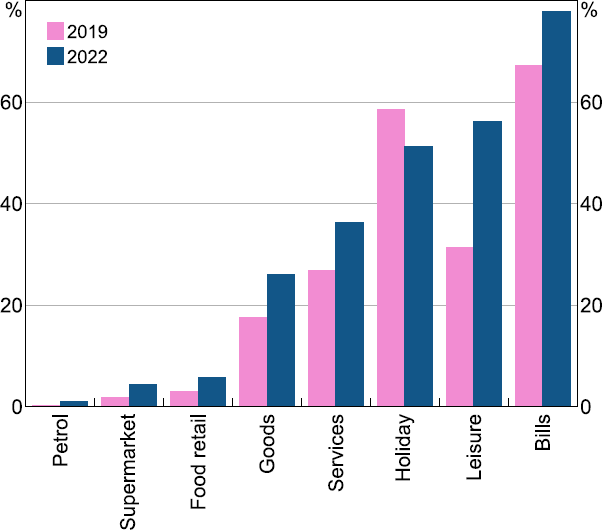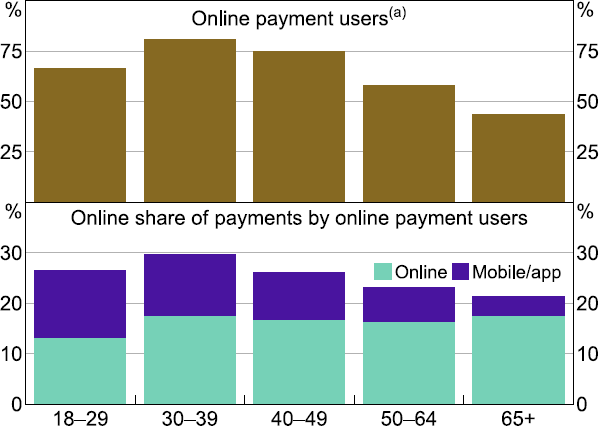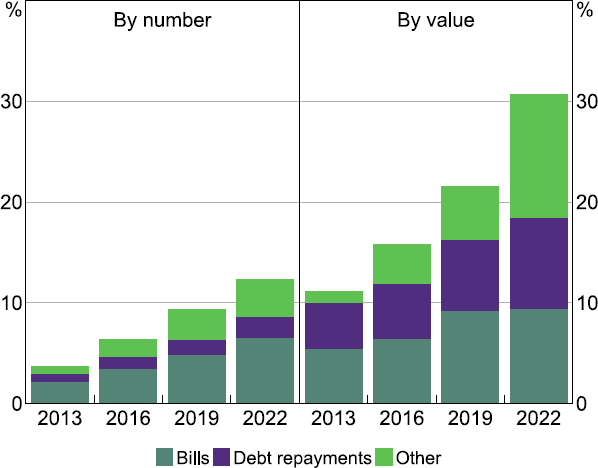RDP 2023-08: The Evolution of Consumer Payments in Australia: Results from the 2022 Consumer Payments Survey 6. Online and Automatic Payments
November 2023
- Download the Paper 2.30MB
6.1 Online
Online payments made up a higher share of retail payments in 2022 than in 2019, with consumers shifting away from in-person transactions. When measured by the number of transactions, the share of payments made online was 18 per cent – up from 13 per cent in 2019 and just 4 per cent in 2007 (Table 6). This reflects the long-term rise in e-commerce, spurred on more recently by lockdowns and social distancing during the pandemic.
Around two-thirds of respondents made at least one online payment in 2022, up from around 55 per cent in 2019 and more than double the share of people surveyed in 2007. Some goods or services are more difficult or more expensive to purchase online – including petrol, supermarket items and food retail – and so only a small share of these purchases are made online (Figure 30). For other types of services – such as leisure, bills and holidays – a high share of purchases are made online. More than half of leisure purchases – such as music, movies and sports tickets – were made online in 2022.
| 2007 | 2010 | 2013 | 2016 | 2019 | 2022 | |
|---|---|---|---|---|---|---|
| Online payments as a share of consumer payments(a) | ||||||
| Number | 4 | 7 | 13 | 13 | 13 | 18 |
| Value | 13 | 26 | 36 | 39 | 35 | 40 |
| Mobile/app as a share of online payments(b) | na | na | 6 | 20 | 40 | 37 |
| Online and automatic payments as a share of total spending(c) | ||||||
| Number | na | na | 16 | 19 | 21 | 29 |
| Value | na | na | 44 | 48 | 49 | 60 |
|
Notes: Numbers published in Caddy et al (2020) differ because of data cleaning approach.
Source: RBA calculations, based on data from Colmar Brunton, Ipsos and Roy Morgan Research. |
||||||

Source: RBA calculations, based on data from Ipsos and Roy Morgan Research.
Consumers are increasingly using their debit cards to make online payments, in addition to BPAY and bank transfers which have historically accounted for the largest share of online payments. In 2022, the share of online payments made using mobile apps was little changed from 2019 at just under 40 per cent, with the remainder initiated through other means such as web browsers (e.g. Chrome or Safari).
The figures for online payments as a share of consumer payments shown in Table 6 do not include participants' automatic payment arrangements (e.g. direct debits), which are recorded separately in a post-diary questionnaire (see Section 6.2 below). When these automatic payment arrangements are included in total spending, the share of total weekly spending accounted for by automatic and online payments has increased by 11 percentage points since 2019 (Table 6).
Online payments continue to be made most frequently by younger respondents. Three-quarters of people aged under 40 made at least one online payment during the 2022 diary week (Figure 31, top panel). The online payment users in this age group made nearly one-third of their weekly purchases online on average, more than half of the time via mobile apps (Figure 31, bottom panel). When respondents in older age groups made online purchases, they tended to use apps less frequently.

Note: (a) Share of respondents who made at least one online payment in the diary week.
Source: RBA calculations, based on data from Ipsos.
6.2 Automatic payments
In addition to recording payments that they initiated during the diary week, respondents were asked details about automatic payments that occurred during the week as part of a post-diary questionnaire. These automatic payments include pre-authorised direct debit payments for bills (e.g. rent, phone and utility bills or digital service subscriptions), regular debt repayments (mortgage or credit card repayments) and recurring ‘pay anyone’ transactions set up via internet banking.
Automatic payment arrangements are becoming more common, with 83 per cent of respondents in 2022 reporting that they had at least one automatic payment arrangement, compared with 65 per cent in 2016. The share of payments made automatically during the week of the CPS has been steadily increasing over recent years, to 12 per cent of the total number of transactions (Figure 32, left panel). By value, nearly one-third of weekly spending was made automatically in 2022 (Figure 32, right panel). The growth in automatic payments reflects the changing way people pay their bills as well as the increasing use of subscription services, such as video streaming and meal services. Two-thirds of all household bill payments in 2022 were made automatically, which is around triple the share in 2013. This shift towards automatic payments for certain transactions is another way in which payments are becoming more convenient for consumers.

Source: RBA calculations, based on data from Colmar Brunton, Ipsos and Roy Morgan Research.